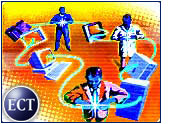
First came the dot-com bubble and then the burst. But with the dot-com shakeout now starting to slow down, what’s next for e-commerce?
New trends will emerge, analysts say, and some have already begun to come to the surface.
The US$1.5 billion-plus takeover of Expedia (Nasdaq: EXPE) by USA Networks could be the highest profile example yet of what is likely to be additional consolidation in the e-commerce space.
“I think we will see more of that kind of marriage of content and commerce,” Christopher Kelley, an analyst with Forrester Research, told the E-Commerce Times. “With financial belts being tightened, people look for more creative ways to figure out how to become profitable.”
Joining Forces
In addition to cross-sector mergers, category consolidation is also likely to be on the upswing, analysts say, with industry leaders taking a cue from Internet job search site Monster.com and its parent TMP Worldwide (Nasdaq: TMPW). TMP recently capped a three-month acquisition spree with the $460 million purchase of leading competitor HotJobs.
According to consolidation watchdog Webmergers, the value of acquisitions reached their highest level to date in June, with a total of $6 billion worth of deals announced. During the first six months of the year, $29 billion was spent to acquire 726 Internet companies, the firm said.
Stagnant stock prices and rock-bottom company valuations have made it abuyer’s market in many sectors.
“Large buyers looking to lock up key markets are driving the blockbuster deals,” Webmergers president Tim Miller said. “It’s different than earlier waves of mergers, which were more about throwing an umbrella over many sectors.”
Home Improvement
In addition to joining forces, many Web sellers are cleaning house. However, now that the layoffs are tapering off, house cleaning for dot-coms will come to mean re-designing and streamlining their Web presence.
For example, auction leader eBay (Nasdaq: EBAY) undertook a redesign of its home page this spring, a move designed to update the page’s look and better integrate the myriad offerings eBay has unveiled.
Weeks earlier, Priceline.com announced it would revamp its home page to make it easier to find and compare travel deals.
Second Look
“Initially, the focus was on getting sites up and running, in some casesdoing it on the fly,” Kelley said. “Now, a lot are going back to see (and) ask,’How solid is my Web site. How good is our customer service?’ They are usingthis downturn to really batten down the hatches.”
The movement will catch on as e-tailers realize how much opportunitythere is to make more sales and boost revenues just by addressing what isalready there. In many cases, it might be a matter of stripping out flashygraphics or smoothing navigational flaws.
“It’s really about going back to basics,” said Kelley. “The majority ofonline shoppers are still technophobes with slow dial-up connections. Thisis taking a new look at what’s being done, with the customer in mind thistime, not the technology.”
Solving Shipping
Another new trend is really the retelling of an old story. E-tailers will continue to struggle with the shipping question, but new approaches are likely.
Even more than determining how to charge for shipping — a question Amazon.com dealt with by testing and then quickly ending a free shipping promotion that also raised product prices — the issue has become how best to communicate shipping arrangements to online shoppers.
Kelley said that consumers on the Net want to know upfront what it is going to cost to ship the goods that they buy. Currently, however, that information is only available when the final checkout process is nearly complete.
No Games
Providing shipping information at the start of the process is symbolic of what may be an overall shift in how online shoppers are seen by Web vendors — with courteous respect. It is not happenstance that “customer relationship management”has become the three-word code for sound business practices.
“Consumers pay a tremendous amount of attention to shipping,” Kelley said.”They don’t see taxes, but they do see shipping.”
Revealing the shipping costs at the end of the shopping experience is like having a customer take a shirt to a department store checkout and having the clerk spin a wheel to determine the taxes, according to Kelley.
“This method is disserving customers,” Kelley added. “I think we’ll seemore e-tailers put that information right on the product page or at theshopping cart. Customers really don’t want to play this game any more.”![]()

















































I AM agree that the e-commerce should have New trend. The e-tailer should re-design their website and give people a new fresh look, plus give more service to customer, for examples http://www.essencompu.com, which I feel very comfortable to shop with.
I think the total price of a sale is important to shoppers on the net. There is a good solution to this issue, price comparison services. The best service I have found is http://www.clickthebutton.com. When you compare prices on a product, it tells you all the vendors that carry the product, their price, and shipping costs.